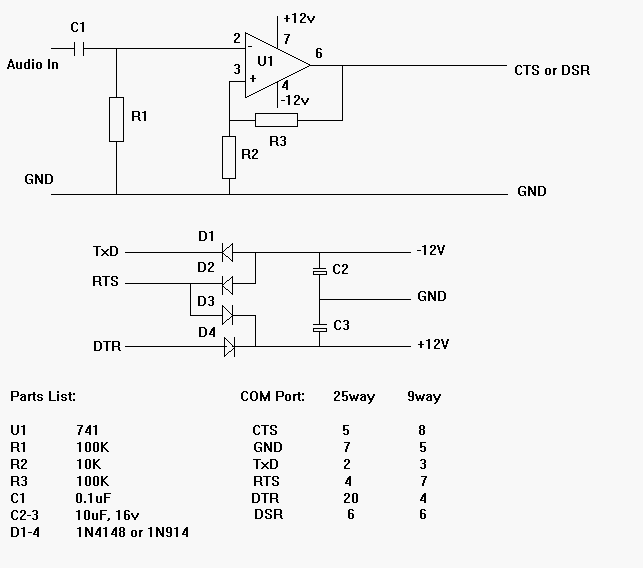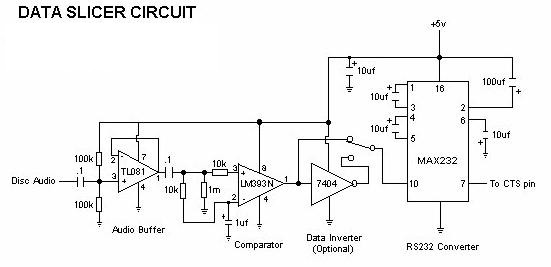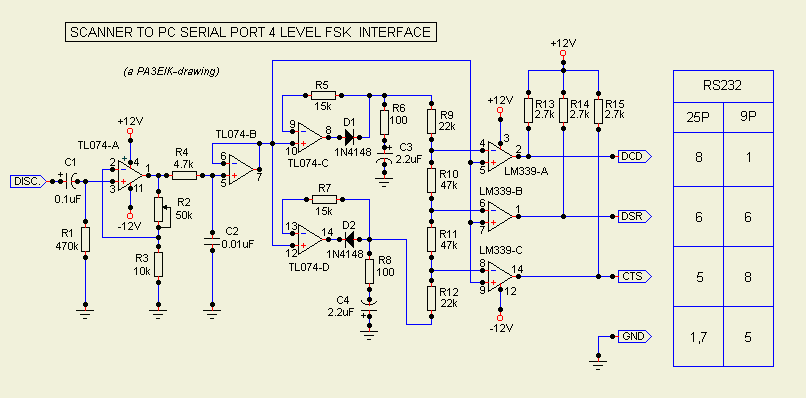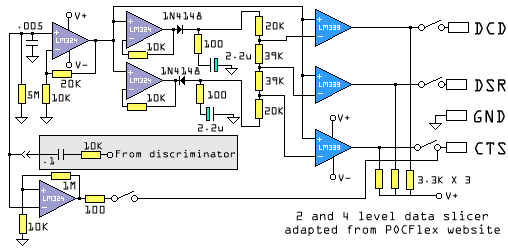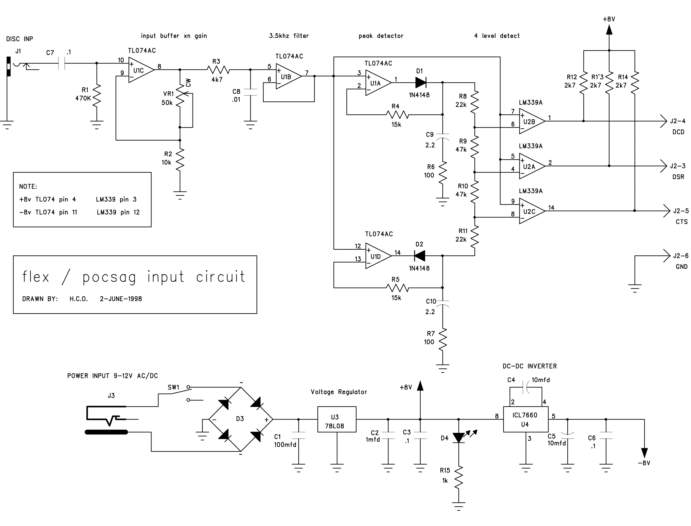Difference between revisions of "Data Slicers"
From The RadioReference Wiki
| (31 intermediate revisions by 11 users not shown) | |||
| Line 1: | Line 1: | ||
| − | Many applications featured on | + | Many applications featured on the [[Trunked Radio Decoders]] article require either the 2-Level FSK interface or the 4-Level FSK interface, otherwise known as a data slicer. You must build this interface, or buy it from some of sources listed at the bottom of the page. NOTE that these interfaces DO NOT provide computer control for your scanner, but rather they interface the output from your scanner so that the computer and application can decode the digital signals. |
These interfaces connect to the [[discriminator output]] on you scanner (and ONLY the discriminator output) This is usually a connection inside of your scanner that must be made with a soldering iron. | These interfaces connect to the [[discriminator output]] on you scanner (and ONLY the discriminator output) This is usually a connection inside of your scanner that must be made with a soldering iron. | ||
| − | + | == The 2-Level Interface == | |
| − | |||
| − | |||
| + | The 2-Level Interface (also called the Hamcom interface) is required for most of the applications that are available for decoding digital signals today. There are numerous different version of this interface, but they all accomplish the same task. You can use the | ||
| + | [http://home.ica.net/~phoenix/wap/slicer.htm Hamcom Tuning Interface Application] to test and adjust the performance. | ||
| + | |||
[[Image:Circut.gif|Normal|2-Level General Hamcom Interface]] | [[Image:Circut.gif|Normal|2-Level General Hamcom Interface]] | ||
| Line 13: | Line 14: | ||
[[Image:Dslicer.jpg|Normal|2-Level General Hamcom Interface]] | [[Image:Dslicer.jpg|Normal|2-Level General Hamcom Interface]] | ||
| − | + | '''NOTE:''' Some TL081 IC's specifically the ST branded ones have the output on pin 6 instead of pin 1. | |
| − | The 4-Level Interface is a new generation of interfaces that are required for the faster digital modes. For decoding Flex paging and RD-LAP MDT modes, this interface will be required. The only production | + | '''NOTE:''' Additional filtering is required when using utilities for LTR Decoding. The schematic may be viewed [[media:LTRDicer1.png|here]] and an updated version |
| + | [[media:LTR_Dicer2.jpg|here]] | ||
| + | |||
| + | == The 4-Level Interface == | ||
| + | |||
| + | The 4-Level Interface is a new generation of interfaces that are required for the faster digital modes. For decoding Flex paging and RD-LAP MDT modes, this interface will be required. The only production applications today that use the 4-Level interface today are Pocflex and [[PDW]]. This interface will however have further uses when APCO-25 decoding becomes possible. A 4-Level interface will decode both 2-Level and 4-Level fsk signals. | ||
[[Image:4levfsk1.gif|Normal|Description]] | [[Image:4levfsk1.gif|Normal|Description]] | ||
| + | |||
| + | Here is a schematic of the 2-level and 4-level interface combined into one interface. It's worth noting that this circuit, as drawn, can only use one fsk decoder at a time. Since the 4-Level half of the circuit can already decode 2-Level signals, a "useful" version would allow both decoders to run simultaneously by connecting the 2-Level decoder to a second com port. | ||
| + | |||
| + | [[Image:2and4.gif|Normal|Description]] | ||
| + | |||
| + | Another version of the 4-level interface with power supply can be found below: | ||
| + | |||
| + | [[Image:Schema.jpg|Normal|Description]] | ||
| + | |||
| + | == Purchasing an Interface == | ||
| + | |||
| + | * [http://www.dataslicers.com Data Slicers Com] sells 2-level data slicers for use with trunker/etrunker and other FSK based decoding applications | ||
| + | * [http://www.discriminator.nl/order/index-en.html discriminator.nl] Sells 2 and 4 level data slicers, as well as a professionally manufactured circuit board for the 4 level slicer | ||
| + | * [http://www.optoelectronics.com/optolinx.htm Optoelectronics Optolinx] | ||
| + | * [http://www.tigertronics.com/bp2info.htm TigerTronics BP2/BP2M Information] | ||
| + | |||
| + | [[Category:RR Glossary]] | ||
| + | [[Category:HF Glossary]] | ||
| + | [[Category:Signal Analysis and Decoding Glossary]] | ||
Latest revision as of 19:51, 19 April 2020
Many applications featured on the Trunked Radio Decoders article require either the 2-Level FSK interface or the 4-Level FSK interface, otherwise known as a data slicer. You must build this interface, or buy it from some of sources listed at the bottom of the page. NOTE that these interfaces DO NOT provide computer control for your scanner, but rather they interface the output from your scanner so that the computer and application can decode the digital signals.
These interfaces connect to the discriminator output on you scanner (and ONLY the discriminator output) This is usually a connection inside of your scanner that must be made with a soldering iron.
The 2-Level Interface
The 2-Level Interface (also called the Hamcom interface) is required for most of the applications that are available for decoding digital signals today. There are numerous different version of this interface, but they all accomplish the same task. You can use the Hamcom Tuning Interface Application to test and adjust the performance.
Here is another schematic of the 2-Level interface based around the MAX232 chipset. This interface is very reliable and is reported to work VERY well with Trunker and Etrunker.
NOTE: Some TL081 IC's specifically the ST branded ones have the output on pin 6 instead of pin 1.
NOTE: Additional filtering is required when using utilities for LTR Decoding. The schematic may be viewed here and an updated version here
The 4-Level Interface
The 4-Level Interface is a new generation of interfaces that are required for the faster digital modes. For decoding Flex paging and RD-LAP MDT modes, this interface will be required. The only production applications today that use the 4-Level interface today are Pocflex and PDW. This interface will however have further uses when APCO-25 decoding becomes possible. A 4-Level interface will decode both 2-Level and 4-Level fsk signals.
Here is a schematic of the 2-level and 4-level interface combined into one interface. It's worth noting that this circuit, as drawn, can only use one fsk decoder at a time. Since the 4-Level half of the circuit can already decode 2-Level signals, a "useful" version would allow both decoders to run simultaneously by connecting the 2-Level decoder to a second com port.
Another version of the 4-level interface with power supply can be found below:
Purchasing an Interface
- Data Slicers Com sells 2-level data slicers for use with trunker/etrunker and other FSK based decoding applications
- discriminator.nl Sells 2 and 4 level data slicers, as well as a professionally manufactured circuit board for the 4 level slicer
- Optoelectronics Optolinx
- TigerTronics BP2/BP2M Information
